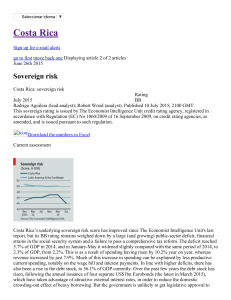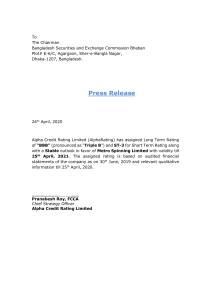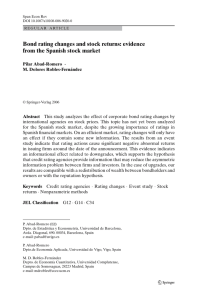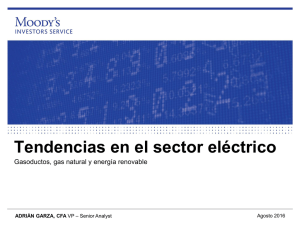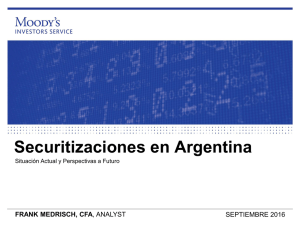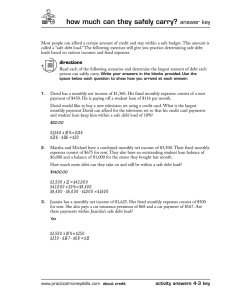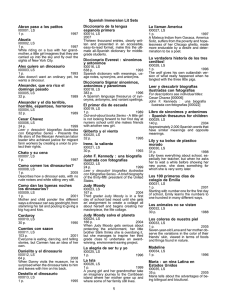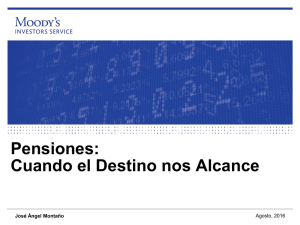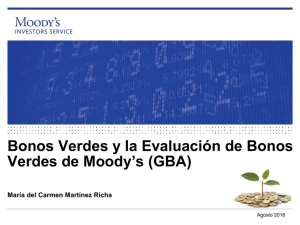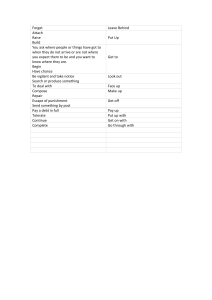Rating Action - Moodys-downgrades-Egypts-ratings-to-B3-changes-outlook-to-stable - 07Feb23
Anuncio
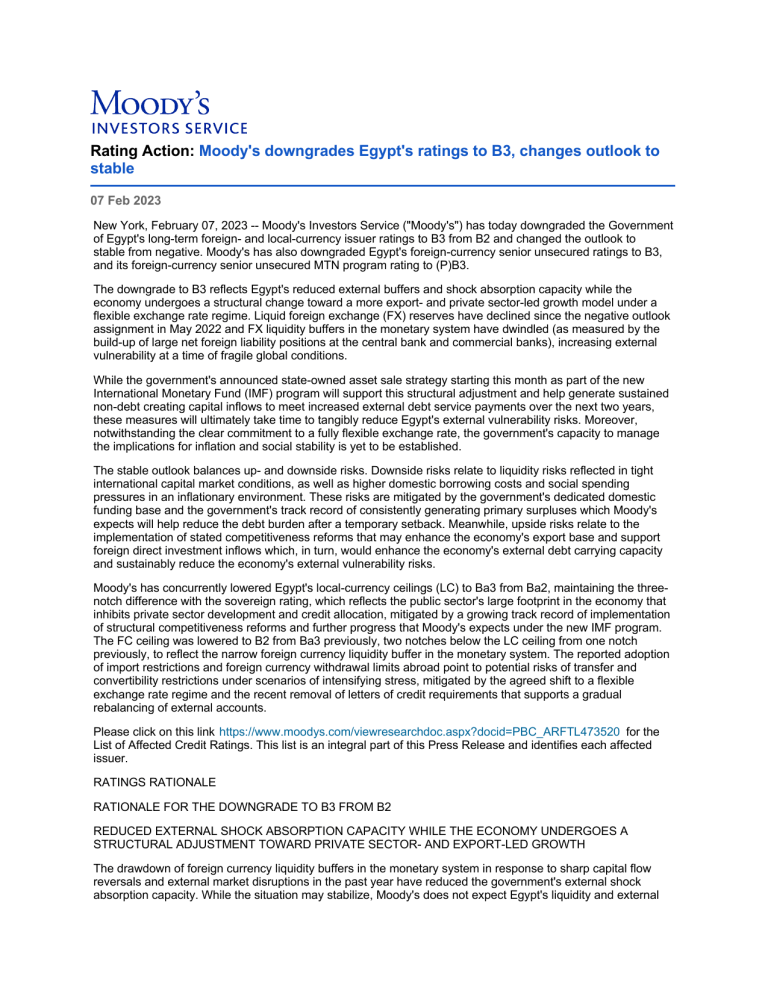
Rating Action: Moody's downgrades Egypt's ratings to B3, changes outlook to stable 07 Feb 2023 New York, February 07, 2023 -- Moody's Investors Service ("Moody's") has today downgraded the Government of Egypt's long-term foreign- and local-currency issuer ratings to B3 from B2 and changed the outlook to stable from negative. Moody's has also downgraded Egypt's foreign-currency senior unsecured ratings to B3, and its foreign-currency senior unsecured MTN program rating to (P)B3. The downgrade to B3 reflects Egypt's reduced external buffers and shock absorption capacity while the economy undergoes a structural change toward a more export- and private sector-led growth model under a flexible exchange rate regime. Liquid foreign exchange (FX) reserves have declined since the negative outlook assignment in May 2022 and FX liquidity buffers in the monetary system have dwindled (as measured by the build-up of large net foreign liability positions at the central bank and commercial banks), increasing external vulnerability at a time of fragile global conditions. While the government's announced state-owned asset sale strategy starting this month as part of the new International Monetary Fund (IMF) program will support this structural adjustment and help generate sustained non-debt creating capital inflows to meet increased external debt service payments over the next two years, these measures will ultimately take time to tangibly reduce Egypt's external vulnerability risks. Moreover, notwithstanding the clear commitment to a fully flexible exchange rate, the government's capacity to manage the implications for inflation and social stability is yet to be established. The stable outlook balances up- and downside risks. Downside risks relate to liquidity risks reflected in tight international capital market conditions, as well as higher domestic borrowing costs and social spending pressures in an inflationary environment. These risks are mitigated by the government's dedicated domestic funding base and the government's track record of consistently generating primary surpluses which Moody's expects will help reduce the debt burden after a temporary setback. Meanwhile, upside risks relate to the implementation of stated competitiveness reforms that may enhance the economy's export base and support foreign direct investment inflows which, in turn, would enhance the economy's external debt carrying capacity and sustainably reduce the economy's external vulnerability risks. Moody's has concurrently lowered Egypt's local-currency ceilings (LC) to Ba3 from Ba2, maintaining the threenotch difference with the sovereign rating, which reflects the public sector's large footprint in the economy that inhibits private sector development and credit allocation, mitigated by a growing track record of implementation of structural competitiveness reforms and further progress that Moody's expects under the new IMF program. The FC ceiling was lowered to B2 from Ba3 previously, two notches below the LC ceiling from one notch previously, to reflect the narrow foreign currency liquidity buffer in the monetary system. The reported adoption of import restrictions and foreign currency withdrawal limits abroad point to potential risks of transfer and convertibility restrictions under scenarios of intensifying stress, mitigated by the agreed shift to a flexible exchange rate regime and the recent removal of letters of credit requirements that supports a gradual rebalancing of external accounts. Please click on this link https://www.moodys.com/viewresearchdoc.aspx?docid=PBC_ARFTL473520 for the List of Affected Credit Ratings. This list is an integral part of this Press Release and identifies each affected issuer. RATINGS RATIONALE RATIONALE FOR THE DOWNGRADE TO B3 FROM B2 REDUCED EXTERNAL SHOCK ABSORPTION CAPACITY WHILE THE ECONOMY UNDERGOES A STRUCTURAL ADJUSTMENT TOWARD PRIVATE SECTOR- AND EXPORT-LED GROWTH The drawdown of foreign currency liquidity buffers in the monetary system in response to sharp capital flow reversals and external market disruptions in the past year have reduced the government's external shock absorption capacity. While the situation may stabilize, Moody's does not expect Egypt's liquidity and external positions to rebound quickly. Liquid FX reserves have declined to $26.7 billion at the end of December 2022 from $29.3 billion at the end of April 2022, while the net foreign liability position in the monetary system has increased to $20 billion at the end of December from $13 billion in April. The drawdown of FX liquidity has significantly reduced coverage of upcoming medium- and long-term external debt service (principal + interest) payments amounting to $20.4 billion in fiscal 2024 (ending June) and $23.2 billion in fiscal 2025, in addition to $26 billion in short-term debt, amid tight external funding conditions. The rating takes into account a gradually narrowing current account deficit to a projected 3% in fiscal 2024 from 3.5% in fiscal 2022 and the financial support measures outlined in the $3-billion, 46-month Extended Fund Facility (EFF) program approved by the IMF on 16 December 2022 to cover the estimated cumulative $17 billion funding gap over the duration of the program, conditional on implementation of continued competitiveness reforms under a durably flexible exchange rate regime as announced by the Central Bank of Egypt on 27 October 2022. The financing sources include almost $9 billion in state-owned asset sales including to regional partners in the Gulf Cooperating Council (GCC) starting this fiscal year, in addition to about $5 billion from official lenders in addition to the $3 billion provided by the IMF. While the government's announced state-owned asset sale strategy under the new State Ownership Policy approved by President Abdel Fattah El-Sisi at the end of 2022 will help increase private sector involvement and bolster the economy's foreign exchange liquidity buffers by generating non-debt creating direct investment inflows, these measures will ultimately take time to tangibly reduce Egypt's external vulnerability risks. In Moody's view, the existence of vested interests within the public sector also carries implementation risks, as highlighted by delays in previously envisioned asset sale programs. TRACK RECORD OF DURABLY FLEXIBLE EXCHANGE RATE REGIME AND PRICE STABILITY CREDENTIALS UNDER THAT REGIME HAVE YET TO BE ESTABLISHED Meanwhile, adhering to a fully flexible exchange rate will be credit positive for Egypt over the medium term. At this stage, the shift to a durably flexible exchange rate regime is complicated by already high inflation and domestic borrowing costs which are being exacerbated by the sharp unwinding of previous real effective exchange rate misalignments. In Moody's view, this complexity raises questions about the central bank's and government's capacity to manage the full consequences of the transition. Since announcing the shift in exchange rate policy in late October 2022, the Egyptian pound has depreciated by almost 35% against the US-dollar, bringing the cumulative depreciation since the start of the Russian invasion of Ukraine in February 2022 to almost 50%, largely replicating the impact of the initial flotation of the currency in November 2016 and among the largest depreciations witnessed globally. While a truly flexible currency regime will foster increased price competitiveness to grow Egypt's export base and help rebalance external accounts by reducing excessive imports and demand for foreign exchange, the pass-through from higher exchange rate volatility in the future carries the risk of potentially prolonging inflationary pressures, resulting in higher than currently assumed interest rates and borrowing costs for the government, in addition to social risks in light of the population's deteriorating purchasing power. With headline inflation running at 21.4% year-on-year in December and core inflation at 24.5% and additional inflationary pressures resulting from the renewed devaluation in January, Moody's expects demand on social spending support measures to increase, reducing the government's spending flexibility. RATIONALE FOR CHANGING THE OUTLOOK TO STABLE FROM NEGATIVE ELEVATED GOVERNMENT LIQUIDITY RISKS ARE MITIGATED BY DEDICATED DOMESTIC FUNDING BASE AND ACCESS TO OFFICIAL EXTERNAL LIQUIDITY SUPPORT Egypt has very high annual gross financing needs at over 30% of GDP in comparison with other similarly rated peers, at a time when domestic and international liquidity conditions remain constrained. The short average maturity of the debt stock at 3.4 years generates large rollover needs of T-bills accounting for about 20% of GDP in the local currency market where the government benefits from a large and dedicated domestic funding base, albeit at higher yields. At the end of January, 91-day yields have increased to 20.6%, close to the postflotation peak at 21.6% reached in July 2017. Inflation pass-through from the most recent depreciation in January points to a further rise in borrowing costs ahead. However, Moody's expects the government to maintain continued access to local currency markets to meet its financing needs even at the cost of crowding out lending to the private sector where claims to total assets have ranged between 20-25% of total assets over the past five years compared to total public sector exposures at 40% - 50% over the same time period. In addition, fiscal authorities continue their effort to extend the average maturity of the debt stock including via the issuance of variable rate debt at longer maturities. On the external side, liquidity risks relate to the increasing commercial bond and note debt servicing schedule (principal + interest) with $4.6 billion coming due in fiscal 2024 and $4.3 billion in fiscal 2025 as per IMF estimates, amid tight external market funding conditions and higher average borrowing costs as a result of higher risk-free rates in advanced economies. In Moody's assessment, frontloaded official loan disbursements under the IMF program this fiscal year help cover immediate financing needs while the government is exploring market debt issuances backed by thirdparty guarantees to help support market access in the future in case of persistently tight financing conditions. Regarding official sector debt maturities, effective rollover needs are eased by the GCC's commitment to extend long- and short-term deposits during the duration of the IMF program. Overall GCC exposures account for 26% of the total external debt stock, or about $40 billion, representing the second largest creditor exposure after multilaterals at $51 billion, or 33% of the total. CURRENT FISCAL ACCOUNTS DETERIORATION MITIGATED BY CONTINUED COMMITMENT TO PRIMARY SURPLUSES High imported inflation, exacerbated by sharp currency devaluation, is fueling higher domestic borrowing costs and inflating the value of the government's foreign currency debt, reversing previous improvements in debt affordability and in the general government debt/GDP ratio. However, Moody's expects that after increasing to over 90% of GDP in fiscal 2023 from about 85% in fiscal 2022, the debt ratio will resume an improving trajectory because of consistent realization of primary surpluses. Similarly, Moody's projects debt affordability as measured by general government interest/revenue to decline again after temporarily increasing to over 45% in fiscal 2023 and 2024 from below 40% in fiscal 2022. In addition to the high interest bill, inflation is exacerbating social challenges which will increase demand for social spending and make the realization of primary surpluses more challenging. However, in Moody's assessment the government remains committed to preserving the track record of consistent primary surpluses since 2018. On the spending side, fiscal authorities have built in spending buffers in the budget to draw upon when needed without jeopardizing the primary surplus target. For instance, during the current fiscal year, the government has approved social spending measures worth 1.7% of GDP covered in the budget, including the expansion of beneficiaries of the Takaful and Karama targeted income support program by 25% to reach 5 million households, which is about 20% of the population, among other measures. On the revenue side, the government continues implementation of the Medium-Term Revenue Strategy that aims to expand the tax-toGDP ratio by 2 percentage points of GDP in fiscal 2027 by improving the efficiency and progressivity of the tax system. IMPLEMENTATION OF COMPETITIVENESS REFORMS SUPPORTS EXPORT GROWTH AND EXTERNAL DEBT CARRYING CAPACITY OVER TIME Improved price competitiveness and the implementation of business environment reforms would over time enhance the economy's export base and support foreign direct investment inflows which would enhance the economy's external debt carrying capacity and sustainably reduce the economy's external vulnerability risks. A comparatively low share of exports of goods and services at below 20% to GDP compared to a world average of closer to 30% currently constrains the amount of current account receipts generated to service the external debt burden which has doubled to 32.8% of GDP in fiscal 2022 since 2016. Regarding the financial account, the initiated shift to less cyclical foreign direct investment inflows and lower reliance on debt-creating inflows would strengthen the resilience of the economy's foreign exchange reserve buffer in the future. ENVIRONMENTAL, SOCIAL, GOVERNANCE CONSIDERATIONS Egypt's ESG Credit Impact Score is highly negative (CIS-4), reflecting high exposure to environmental and social risks respectively. The sovereign's high debt burden, relatively low income levels and governance challenges constrain its capacity to respond to environmental and social risks, although remedy strategies are being implemented. Egypt's highly negative exposure to environmental risks (E-4 issuer profile score) mainly relates to high water risk through the country's dependency on the Nile and the high degree of air pollution in densely populated cities. The Nile's flow has been affected by the decreasing rate of annual rainwater, leading to very high fresh water resource depletion rates which the government seeks to address via the installation of desalination plants and the application of strict rules for the cultivation of water-intensive crops such as rice desalination plants and the application of strict rules for the cultivation of water-intensive crops such as rice and sugarcane. As climate change intensifies, Egypt is also among the sovereigns most exposed to rising sea levels, with up to 10%-25% of the population or GDP exposed over the next decades. Exposure to social risks is highly negative (S-4 issuer profile score), driven by low employment rates that constrain the absorption of the young and expanding labor force, resulting in high youth unemployment rates at over 25% of the labor force, including among graduates. Relatively high poverty rates and gender inequality also contribute to social risks which have been exacerbated by the large economic reform adjustment costs borne by consumers over the past few years. As part of the government's reform effort, social risks are being mitigated by a more targeted social safety net, although the breadth coverage remains relatively narrow. Egypt has a highly negative governance profile score (G-4 issuer profile), reflecting weak performance on voice and accountability and the perception of relatively few formal checks on the exercise of government power, including from the side of civil society. In recent years, significant progress in the implementation of fiscal reforms denote improvements in fiscal policy effectiveness, constrained by high debt levels and a large interest bill. Monetary and macro policy has been relatively ineffective in the past in preventing the build-up of imbalances that have led to structurally weak competitiveness and necessitated abrupt adjustments. The government has more recently committed to a flexible exchange rate regime to boost its competitiveness and expand its export base to enhance its external debt carrying capacity. GDP per capita (PPP basis, US$): 14,256 (2021) (also known as Per Capita Income) Real GDP growth (% change): 3.3% (2021) (also known as GDP Growth) Inflation Rate (CPI, % change Dec/Dec): 5.9% (2021) Gen. Gov. Financial Balance/GDP: -7% (2021) (also known as Fiscal Balance) Current Account Balance/GDP: -4.4% (2021) (also known as External Balance) External debt/GDP: 32.6% (2021) Economic resiliency: baa3 Default history: No default events (on bonds or loans) have been recorded since 1983. On 02 February 2023, a rating committee was called to discuss the rating of the Egypt, Government of. The main points raised during the discussion were: The issuer's institutions and governance strength, has materially decreased. The issuer's governance and/or management, have not materially changed. The issuer's fiscal or financial strength, including its debt profile, has not materially changed. The systemic risk in which the issuer operates has not materially changed. The issuer has become increasingly susceptible to event risks. Other views raised included: The issuer's economic fundamentals, including its economic strength, have not materially changed. FACTORS THAT COULD LEAD TO AN UPGRADE OR DOWNGRADE OF THE RATINGS The rating would likely be upgraded upon evidence of a structural shift to a growth model that generates the foreign exchange proceeds to meet external debt service payments on a self-sustained basis. This would be reflected in a growing non-hydrocarbon export share over time and a sustained build-up in the foreign exchange liquidity buffer supported by non-debt creating inflows. A sustained improvement in debt/GDP and interest/revenue metrics in line with peers as a result of continued primary surpluses and longer average debt maturities would also put upward pressure on the rating. Conversely, reversal of adopted reform commitments or limited effectiveness of the reforms under the IMF program that leads to reduced official support; or a sustained deterioration in debt/GDP or interest/revenue metrics resulting from the materialization of social or political risk would exert negative pressure on the rating. The principal methodology used in these ratings was Sovereigns published in November 2022 and available at https://ratings.moodys.com/api/rmc-documents/395819 . Alternatively, please see the Rating Methodologies page on https://ratings.moodys.com for a copy of this methodology. The weighting of all rating factors is described in the methodology used in this credit rating action, if applicable. REGULATORY DISCLOSURES The List of Affected Credit Ratings announced here are a mix of solicited and unsolicited credit ratings. For additional information, please refer to Moody's Policy for Designating and Assigning Unsolicited Credit Ratings available on its website https://ratings.moodys.com. Additionally, the List of Affected Credit Ratings includes additional disclosures that vary with regard to some of the ratings. Please click on this link https://www.moodys.com/viewresearchdoc.aspx?docid=PBC_ARFTL473520 for the List of Affected Credit Ratings. This list is an integral part of this Press Release and provides, for each of the credit ratings covered, Moody's disclosures on the following items: • EU Endorsement Status • UK Endorsement Status • Rating Solicitation • Issuer Participation • Participation: Access to Management • Participation: Access to Internal Documents • Lead Analyst • Releasing Office For further specification of Moody's key rating assumptions and sensitivity analysis, see the sections Methodology Assumptions and Sensitivity to Assumptions in the disclosure form. Moody's Rating Symbols and Definitions can be found on https://ratings.moodys.com/rating-definitions. For ratings issued on a program, series, category/class of debt or security this announcement provides certain regulatory disclosures in relation to each rating of a subsequently issued bond or note of the same series, category/class of debt, security or pursuant to a program for which the ratings are derived exclusively from existing ratings in accordance with Moody's rating practices. For ratings issued on a support provider, this announcement provides certain regulatory disclosures in relation to the credit rating action on the support provider and in relation to each particular credit rating action for securities that derive their credit ratings from the support provider's credit rating. For provisional ratings, this announcement provides certain regulatory disclosures in relation to the provisional rating assigned, and in relation to a definitive rating that may be assigned subsequent to the final issuance of the debt, in each case where the transaction structure and terms have not changed prior to the assignment of the definitive rating in a manner that would have affected the rating. For further information please see the issuer/deal page for the respective issuer on https://ratings.moodys.com. For any affected securities or rated entities receiving direct credit support from the primary entity(ies) of this credit rating action, and whose ratings may change as a result of this credit rating action, the associated regulatory disclosures will be those of the guarantor entity. Exceptions to this approach exist for the following disclosures, if applicable to jurisdiction: Ancillary Services, Disclosure to rated entity, Disclosure from rated entity. The ratings have been disclosed to the rated entity or its designated agent(s) and issued with no amendment resulting from that disclosure. Regulatory disclosures contained in this press release apply to the credit rating and, if applicable, the related rating outlook or rating review. Moody's general principles for assessing environmental, social and governance (ESG) risks in our credit analysis can be found at https://ratings.moodys.com/documents/PBC_1288235 . At least one ESG consideration was material to the credit rating action(s) announced and described above. Please see https://ratings.moodys.com for any updates on changes to the lead rating analyst and to the Moody's legal entity that has issued the rating. Please see the issuer/deal page on https://ratings.moodys.com for additional regulatory disclosures for each credit rating. Elisa Parisi-Capone Vice President - Senior Analyst Sovereign Risk Group Moody's Investors Service, Inc. 250 Greenwich Street New York, NY 10007 U.S.A. JOURNALISTS: 1 212 553 0376 Client Service: 1 212 553 1653 Matt Robinson Associate Managing Director Sovereign Risk Group JOURNALISTS: 44 20 7772 5456 Client Service: 44 20 7772 5454 Releasing Office: Moody's Investors Service, Inc. 250 Greenwich Street New York, NY 10007 U.S.A. JOURNALISTS: 1 212 553 0376 Client Service: 1 212 553 1653 © 2023 Moody’s Corporation, Moody’s Investors Service, Inc., Moody’s Analytics, Inc. and/or their licensors and affiliates (collectively, “MOODY’S”). All rights reserved. CREDIT RATINGS ISSUED BY MOODY'S CREDIT RATINGS AFFILIATES ARE THEIR CURRENT OPINIONS OF THE RELATIVE FUTURE CREDIT RISK OF ENTITIES, CREDIT COMMITMENTS, OR DEBT OR DEBT-LIKE SECURITIES, AND MATERIALS, PRODUCTS, SERVICES AND INFORMATION PUBLISHED BY MOODY’S (COLLECTIVELY, “PUBLICATIONS”) MAY INCLUDE SUCH CURRENT OPINIONS. MOODY’S DEFINES CREDIT RISK AS THE RISK THAT AN ENTITY MAY NOT MEET ITS CONTRACTUAL FINANCIAL OBLIGATIONS AS THEY COME DUE AND ANY ESTIMATED FINANCIAL LOSS IN THE EVENT OF DEFAULT OR IMPAIRMENT. SEE APPLICABLE MOODY’S RATING SYMBOLS AND DEFINITIONS PUBLICATION FOR INFORMATION ON THE TYPES OF CONTRACTUAL FINANCIAL OBLIGATIONS ADDRESSED BY MOODY’S CREDIT RATINGS. CREDIT RATINGS DO NOT ADDRESS ANY OTHER RISK, INCLUDING BUT NOT LIMITED TO: LIQUIDITY RISK, MARKET VALUE RISK, OR PRICE VOLATILITY. CREDIT RATINGS, NON-CREDIT ASSESSMENTS (“ASSESSMENTS”), AND OTHER OPINIONS INCLUDED IN MOODY’S PUBLICATIONS ARE NOT STATEMENTS OF CURRENT OR HISTORICAL FACT. MOODY’S PUBLICATIONS MAY ALSO INCLUDE QUANTITATIVE MODEL-BASED ESTIMATES OF CREDIT RISK AND RELATED OPINIONS OR COMMENTARY PUBLISHED BY MOODY’S ANALYTICS, INC. AND/OR ITS AFFILIATES. MOODY’S CREDIT RATINGS, ASSESSMENTS, OTHER OPINIONS AND PUBLICATIONS DO NOT CONSTITUTE OR PROVIDE INVESTMENT OR FINANCIAL ADVICE, AND MOODY’S CREDIT RATINGS, ASSESSMENTS, OTHER OPINIONS AND PUBLICATIONS ARE NOT AND DO NOT PROVIDE RECOMMENDATIONS TO PURCHASE, SELL, OR HOLD PARTICULAR SECURITIES. MOODY’S CREDIT RATINGS, ASSESSMENTS, OTHER OPINIONS AND PUBLICATIONS DO NOT COMMENT ON THE SUITABILITY OF AN INVESTMENT FOR ANY PARTICULAR INVESTOR. MOODY’S ISSUES ITS CREDIT RATINGS, ASSESSMENTS AND OTHER OPINIONS AND PUBLISHES ITS PUBLICATIONS WITH THE EXPECTATION AND UNDERSTANDING THAT EACH INVESTOR WILL, WITH DUE CARE, MAKE ITS OWN STUDY AND EVALUATION OF EACH SECURITY THAT IS UNDER CONSIDERATION FOR PURCHASE, HOLDING, OR SALE. MOODY’S CREDIT RATINGS, ASSESSMENTS, OTHER OPINIONS, AND PUBLICATIONS ARE NOT INTENDED FOR USE BY RETAIL INVESTORS AND IT WOULD BE RECKLESS AND INAPPROPRIATE FOR RETAIL INVESTORS TO USE MOODY’S CREDIT RATINGS, ASSESSMENTS, OTHER OPINIONS OR PUBLICATIONS WHEN MAKING AN INVESTMENT DECISION. IF IN DOUBT YOU SHOULD CONTACT YOUR FINANCIAL OR OTHER PROFESSIONAL ADVISER. ALL INFORMATION CONTAINED HEREIN IS PROTECTED BY LAW, INCLUDING BUT NOT LIMITED TO, COPYRIGHT LAW, AND NONE OF SUCH INFORMATION MAY BE COPIED OR OTHERWISE REPRODUCED, REPACKAGED, FURTHER TRANSMITTED, TRANSFERRED, DISSEMINATED, REDISTRIBUTED OR RESOLD, OR STORED FOR SUBSEQUENT USE FOR ANY SUCH PURPOSE, IN WHOLE OR IN PART, IN ANY FORM OR MANNER OR BY ANY MEANS WHATSOEVER, BY ANY PERSON WITHOUT MOODY’S PRIOR WRITTEN CONSENT. MOODY’S CREDIT RATINGS, ASSESSMENTS, OTHER OPINIONS AND PUBLICATIONS ARE NOT INTENDED FOR USE BY ANY PERSON AS A BENCHMARK AS THAT TERM IS DEFINED FOR REGULATORY PURPOSES AND MUST NOT BE USED IN ANY WAY THAT COULD RESULT IN THEM BEING CONSIDERED A BENCHMARK. All information contained herein is obtained by MOODY’S from sources believed by it to be accurate and reliable. Because of the possibility of human or mechanical error as well as other factors, however, all information contained herein is provided “AS IS” without warranty of any kind. MOODY'S adopts all necessary measures so that the information it uses in assigning a credit rating is of sufficient quality and from sources MOODY'S considers to be reliable including, when appropriate, independent third-party sources. However, MOODY’S is not an auditor and cannot in every instance independently verify or validate information received in the credit rating process or in preparing its Publications. To the extent permitted by law, MOODY’S and its directors, officers, employees, agents, representatives, licensors and suppliers disclaim liability to any person or entity for any indirect, special, consequential, or incidental losses or damages whatsoever arising from or in connection with the information contained herein or the use of or inability to use any such information, even if MOODY’S or any of its directors, officers, employees, agents, representatives, licensors or suppliers is advised in advance of the possibility of such losses or damages, including but not limited to: (a) any loss of present or prospective profits or (b) any loss or damage arising where the relevant financial instrument is not the subject of a particular credit rating assigned by MOODY’S. To the extent permitted by law, MOODY’S and its directors, officers, employees, agents, representatives, licensors and suppliers disclaim liability for any direct or compensatory losses or damages caused to any person or entity, including but not limited to by any negligence (but excluding fraud, willful misconduct or any other type of liability that, for the avoidance of doubt, by law cannot be excluded) on the part of, or any contingency within or beyond the control of, MOODY’S or any of its directors, officers, employees, agents, representatives, licensors or suppliers, arising from or in connection with the information contained herein or the use of or inability to use any such information. NO WARRANTY, EXPRESS OR IMPLIED, AS TO THE ACCURACY, TIMELINESS, COMPLETENESS, MERCHANTABILITY OR FITNESS FOR ANY PARTICULAR PURPOSE OF ANY CREDIT RATING, ASSESSMENT, OTHER OPINION OR INFORMATION IS GIVEN OR MADE BY MOODY’S IN ANY FORM OR MANNER WHATSOEVER. Moody’s Investors Service, Inc., a wholly-owned credit rating agency subsidiary of Moody’s Corporation (“MCO”), hereby discloses that most issuers of debt securities (including corporate and municipal bonds, debentures, notes and commercial paper) and preferred stock rated by Moody’s Investors Service, Inc. have, prior to assignment of any credit rating, agreed to pay to Moody’s Investors Service, Inc. for credit ratings opinions and services rendered by it fees ranging from $1,000 to approximately $5,000,000. MCO and Moody’s Investors Service also maintain policies and procedures to address the independence of Moody’s Investors Service credit ratings and credit rating processes. Information regarding certain affiliations that may exist between directors of MCO and rated entities, and between entities who hold credit ratings from Moody’s Investors Service, Inc. and have also publicly reported to the SEC an ownership interest in MCO of more than 5%, is posted annually at www.moodys.com under the heading “Investor Relations — Corporate Governance — Charter Documents - Director and Shareholder Affiliation Policy.” Additional terms for Australia only: Any publication into Australia of this document is pursuant to the Australian Financial Services License of MOODY’S affiliate, Moody’s Investors Service Pty Limited ABN 61 003 399 657AFSL 336969 and/or Moody’s Analytics Australia Pty Ltd ABN 94 105 136 972 AFSL 383569 (as applicable). This document is intended to be provided only to “wholesale clients” within the meaning of section 761G of the Corporations Act 2001. By continuing to access this document from within Australia, you represent to MOODY’S that you are, or are accessing the document as a representative of, a “wholesale client” and that neither you nor the entity you represent will directly or indirectly disseminate this document or its contents to “retail clients” within the meaning of section 761G of the Corporations Act 2001. MOODY’S credit rating is an opinion as to the creditworthiness of a debt obligation of the issuer, not on the equity securities of the issuer or any form of security that is available to retail investors. Additional terms for Japan only: Moody's Japan K.K. (“MJKK”) is a wholly-owned credit rating agency subsidiary of Moody's Group Japan G.K., which is wholly-owned by Moody’s Overseas Holdings Inc., a wholly-owned subsidiary of MCO. Moody’s SF Japan K.K. (“MSFJ”) is a wholly-owned credit rating agency subsidiary of MJKK. MSFJ is not a Nationally Recognized Statistical Rating Organization (“NRSRO”). Therefore, credit ratings assigned by MSFJ are Non-NRSRO Credit Ratings. Non-NRSRO Credit Ratings are assigned by an entity that is not a NRSRO and, consequently, the rated obligation will not qualify for certain types of treatment under U.S. laws. MJKK and MSFJ are credit rating agencies registered with the Japan Financial Services Agency and their registration numbers are FSA Commissioner (Ratings) No. 2 and 3 respectively. MJKK or MSFJ (as applicable) hereby disclose that most issuers of debt securities (including corporate and municipal bonds, debentures, notes and commercial paper) and preferred stock rated by MJKK or MSFJ (as applicable) have, prior to assignment of any credit rating, agreed to pay to MJKK or MSFJ (as applicable) for credit ratings opinions and services rendered by it fees ranging from JPY100,000 to approximately JPY550,000,000. MJKK and MSFJ also maintain policies and procedures to address Japanese regulatory requirements.
